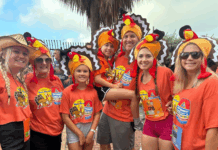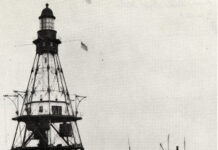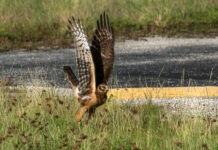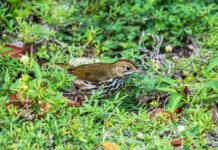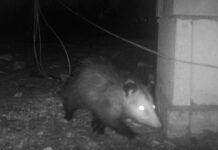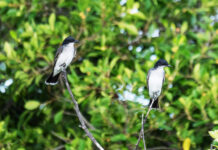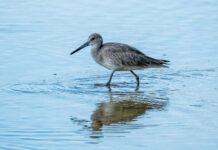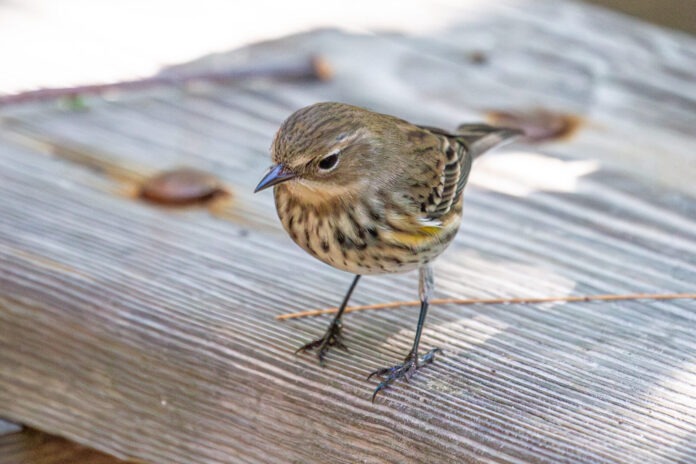
A while ago I wrote a piece for BWD, a national magazine sometimes known as Bird Watchers Digest. The story, which ran in their most recent issue, was about a species called the Cuban finch and was something of a wind-up because, as anyone who used to play in the trivia game I hosted for several years at Mary Ellen’s Bar knows, there is pretty much no such thing as a Cuban finch. It’s a mythical creature, like a unicorn or a midwestern Parrothead that tips well.
There is a long-believed, Conch-based-but-widely-dispersed myth in Key West that there are these little finches in Cuba who are sitting there, idly tweeting in the branches of the native trees, when the wind, often a hurricane wind, comes up. The poor creatures are then caught tragically unaware of the wind’s approach, and are blown, tumbling, against their will, across the Florida Straits, all the way to the shores of our fair island. Once they land here, their story becomes either tragic (they starve to death) or heroic (they valiantly find their footing in this new and unfamiliar land).
It’s not that the birds people call Cuban finches aren’t real. It’s that the birds aren’t Cuban finches. Rather, they are one, or sometimes more than one, of the 39 different warbler species that have been recorded in the Keys. They weren’t blown over here by a terrible storm. They were migrating, either south to north in the spring, or north to south in the fall. They tend to be seen more often when a storm passes because, when possible, birds avoid danger by landing when weather gets sketchy.
You may or may not have noticed that I used the weasel words “pretty much” before saying there is no such thing as a Cuban finch. Because it gets a little complicated. In the broader sense, birds generally know how to avoid the effects of storms. But not always. And they do, in fact, occasionally get blown into the Keys by storms. But the Cuban species that end up here (as well as Bahamian and other Caribbean species) are usually individuals or, at most, pairs or small handfuls. In ornithological terms they are called accidentals. But they are not what people are seeing and calling Cuban finches.
For more than a century, the official English names of birds, both general and scientific, have been codified by a group that in modern times is called the North American Classification Committee of the American Ornithologist Society. There is no species of bird in their taxonomic tree called the Cuban finch, and there never has been.
But (heavy sigh) pet bird fanciers do have a bird they call the Cuban finch. Only ornithologists call the species the yellow-faced grassquit. And while the species has been recorded in the United States, there are only a total of eight sightings, three of which are considered to be escaped pets. So the birds that Key Westers call Cuban finches are not the same birds that pet bird fanciers call Cuban finches.
Part of the basic ethos of birdwatching is to identify the birds you see by the correct name. Another part is to help educate others, who may be less experienced, about what they are seeing. (It helps if they seem remotely interested.)
A lot of the story I wrote for BWD was about this sense of responsibility, and how important it is to execute that responsibility carefully, to not come off as a know-it-all blowhard. People do not always take kindly to being disabused of long-held beliefs. They do not always like to learn that what felt to them like insider information was actually a narrative that didn’t hold water.
As an example of a time in which I screwed this up, I wrote about an incident with my friend Robert – last name redacted for privacy issues – who is a Conch, and with whom I play a lot of poker. This was years ago, and I can’t remember exactly which year or which hurricane, I just remember it was a Category 1 storm, so not much to worry about. We were playing a game at a friend’s house on Garrison Bight, and when the eye passed over we took a break, and Robert and I went with drinks, most likely Scotch, out onto the porch to take advantage of the respite.
I might have said something about how birds can sometimes get caught in the eye of the storm, and will ride things out in the oasis of calm weather.
Which may have inspired Robert to tell me that he’d had a lot of Cuban finches in his yard lately.
And, well, hurricanes are stressful, we’d had whiskey, and I was probably down to felt, chipswise, in the game. And it is within the realm of possibilities that I may not have given him the most patient answer in the world. And that non-patient answer may have been laced with profanity and a soupçon of smarty-boots sarcasm.
This incident resulted in two things.
One, any time Robert now sees a bird in his yard – rooster, osprey, turkey vulture, mockingbird – he sends me a blurry iPhone photo of it with the caption, “Look! A Cuban finch!”
And two, now that people in my poker game know that the whole Cuban finch thing bothers me, at social events they have been known to coax people into coming up to me wanting to talk about Cuban finches. Which means I no longer know if someone is messing with me about the whole Cuban finch thing, or if they are sincere.
BWD is a subscription-based magazine, but when the story came out, since he was mentioned, my wife sent him a Xerox of it. We didn’t hear back for a week or two, possibly because the new season of “Star Trek: Strange New Worlds” just came out. But the other morning I got a text.
It was a screen cap for the Wikipedia page for the Cuban bullfinch.
“OK. Finally, I read Mark’s Cuban finch article. Hahaha. But, I present to you that there are Cuban finches. They’re called Cuban bullfinches. Here’s a picture. I believe you need to update that article. Cuban finches (are the) big lie no more!” he wrote.
I could have explained about how Old World bullfinches were actually in the finch family, and were called that because they had proportionally big heads. And that the Cuban bullfinch was called that because it was similarly big-headed, but was a New World species, and actually in the tanager family, not the finch family. But that seemed like a lot to text before I finished my coffee.
Instead I snarked back, “Notice how the word ‘bullfinch’ has more letters than the work ‘finch’? That’s because they are different words indicating different things.”
“Semantics!” he wrote.

